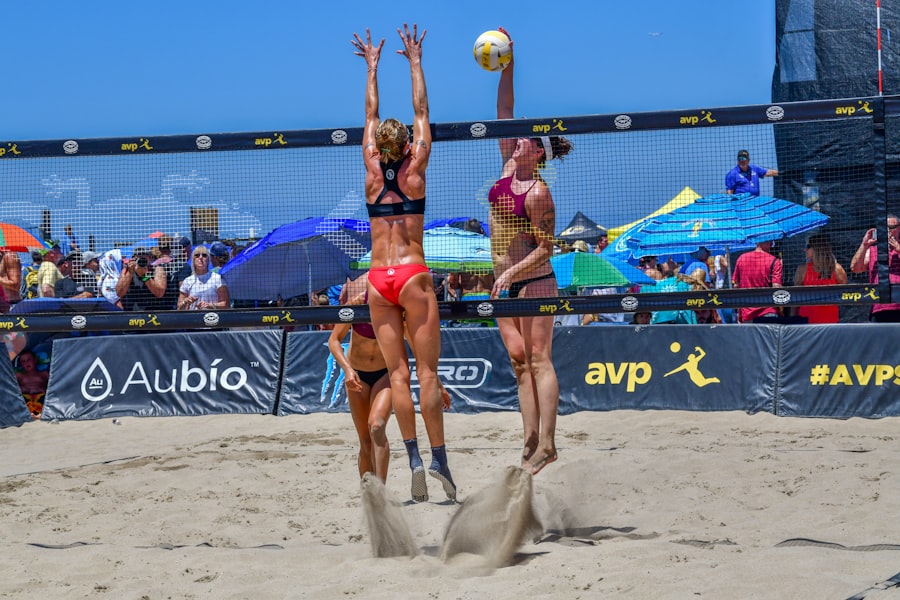Mastering the Basics of Volleyball
Description
To excel in volleyball, a comprehensive understanding of the rules is paramount. The game is played between two teams, each consisting of six players, on a rectangular court divided by a net. The primary objective is to score points by sending the ball over the net and into the opponent’s court, while preventing the opposing team from doing the same.
Each team is allowed a maximum of three touches to return the ball, and the rally continues until one team fails to return the ball or commits a fault. Familiarity with these basic rules is essential, but it is equally important to grasp the nuances that govern play, such as rotation, substitutions, and scoring systems.
In traditional indoor volleyball, matches are typically played in a best-of-five sets format, with a team needing to reach 25 points to win a set, provided they maintain at least a two-point lead. In contrast, beach volleyball employs a slightly different scoring method, where matches are played in a best-of-three sets format, with the first two sets played to 21 points and a potential third set to 15 points. Understanding these variations not only helps players strategize effectively but also prepares them for different competitive environments.
Additionally, players must be aware of specific infractions such as net violations, foot faults during serves, and illegal hits, which can lead to point deductions or turnovers.
Key Takeaways
- Understanding the rules of the game is essential for success in volleyball
- Mastering fundamental skills such as serving, passing, and setting is crucial for players at all levels
- Developing proper footwork and body positioning can greatly improve a player’s performance on the court
- Learning effective serving techniques can give a team a competitive edge in matches
- Improving passing and setting abilities is key for a well-rounded and effective volleyball player
Mastering the Fundamental Skills
Serving: The First Opportunity to Impact the Game
Serving is often the first chance a player has to make an impact on the game. Mastering various serving techniques, such as underhand, overhand, and jump serves, can provide a significant advantage. A well-executed serve can disrupt the opposing team’s formation and create scoring opportunities.
Passing: The Backbone of Effective Play
Passing is another fundamental skill that serves as the foundation of effective play. A good pass allows for accurate setting, which is crucial for executing offensive plays. Players must develop their ability to receive serves and attacks with proper technique, ensuring that they can deliver clean passes to their setter. This involves using both forearm passes (or bumps) and overhead passes (or sets) depending on the situation.
Building a Solid Foundation through Practice and Drills
The ability to read the ball’s trajectory and react quickly is essential for successful passing. As players refine these fundamental skills through consistent practice and drills, they build a solid foundation that will support their overall performance on the court.
Developing Proper Footwork and Body Positioning

Footwork and body positioning are critical components of effective volleyball play. Proper footwork allows players to move swiftly and efficiently around the court, enabling them to respond to various game situations. For instance, when receiving a serve or an attack from an opponent, players must position themselves correctly to ensure they can make an effective play on the ball. This often involves quick lateral movements and precise foot placement to maintain balance and readiness for action. In addition to footwork, body positioning plays a vital role in executing skills such as passing and hitting.
Players must learn to position their bodies in relation to the ball, ensuring they are aligned correctly for optimal contact. For example, when preparing to hit, a player should approach the ball with an open stance that allows for maximum power and accuracy. This involves bending the knees slightly and using a strong arm swing while maintaining balance throughout the motion.
Practicing footwork drills—such as ladder drills or cone drills—can significantly enhance agility and coordination, ultimately leading to improved performance during matches.
Learning Effective Serving Techniques
| Technique | Success Rate | Accuracy | Power |
|---|---|---|---|
| Topspin Serve | 80% | 90% | 70% |
| Flat Serve | 75% | 85% | 80% |
| Slice Serve | 70% | 80% | 75% |
Serving is one of the most critical skills in volleyball, as it initiates each rally and can set the tone for the entire game. There are several types of serves that players can utilize, each with its own strategic advantages. The underhand serve is often used by beginners due to its simplicity; however, more advanced players typically favor overhand serves for their potential to generate speed and spin.
The jump serve has gained popularity in recent years due to its ability to create unpredictable trajectories that can challenge opponents’ reception. To master serving techniques, players should focus on their grip, toss, and follow-through. A consistent toss is essential for executing an effective serve; it should be high enough to allow for optimal contact with the ball at its peak height.
Additionally, players should practice generating power through their legs and core while maintaining control of their arm swing. Incorporating drills that focus on serving accuracy—such as targeting specific areas of the court or serving under pressure—can help players develop confidence in their serving abilities.
Improving Passing and Setting Abilities
Passing and setting are two interconnected skills that form the foundation of a successful offense in volleyball. A well-executed pass allows the setter to deliver an accurate set to an attacker, creating scoring opportunities for the team. To improve passing abilities, players must focus on their hand positioning and body mechanics when receiving serves or attacks.
Proper technique involves using a stable platform created by joining hands together or using forearms for bumps. Setting requires not only technical skill but also an understanding of timing and communication with teammates. A setter must be able to read the play quickly and make split-second decisions about where to place the ball based on their teammates’ positions and movements.
Practicing various setting drills—such as setting from different angles or heights—can enhance a setter’s versatility and adaptability during matches. Additionally, developing a strong connection with hitters through consistent practice can lead to more effective offensive plays.
Enhancing Hitting and Blocking Techniques

Mastering the Approach
Hitting is one of the most exciting aspects of volleyball, as it often leads to points scored through powerful attacks. To enhance hitting techniques, players must focus on their approach, timing, and follow-through. A strong approach involves taking several quick steps toward the ball while maintaining balance and rhythm.
Timing is Everything
Timing is crucial; players must jump at the right moment to make contact with the ball at its highest point for maximum power.
Effective blocking requires anticipation and positioning; players must read their opponents’ movements and be prepared to jump at the right time to intercept spikes. Practicing blocking drills that emphasize footwork and hand positioning can significantly improve a player’s ability to execute successful blocks during matches. Additionally, understanding how to work in tandem with teammates during blocking scenarios can create a formidable defensive front.
Understanding Defensive Strategies
Defensive strategies are essential for any volleyball team aiming for success on the court. A solid defense can thwart opponents’ attacks and create opportunities for counterattacks. One fundamental defensive strategy is positioning players effectively based on their strengths and weaknesses as well as those of their opponents.
For instance, having strong defenders positioned in key areas of the court can help cover potential attack zones. Another critical aspect of defense is communication among teammates. Players must be vocal about their intentions during plays—calling for balls or signaling defensive shifts—to ensure everyone is on the same page.
Implementing defensive formations such as perimeter defense or rotation defense can also enhance a team’s ability to respond effectively to various offensive strategies employed by opponents. Regularly practicing defensive drills that simulate game scenarios can help players develop instincts for reading plays and reacting accordingly.
Practicing Team Communication and Coordination
Effective communication and coordination among teammates are vital components of successful volleyball play. The fast-paced nature of the game necessitates clear communication both on and off the court. Players should develop a common language that includes verbal cues for calling balls, signaling plays, or indicating defensive shifts.
This shared vocabulary fosters trust among teammates and enhances overall performance during matches. Coordination extends beyond verbal communication; it also involves understanding each player’s role within various formations and strategies. Practicing team drills that emphasize synchronization—such as running through offensive plays or defensive rotations—can help build chemistry among players.
Additionally, fostering an environment where teammates feel comfortable providing constructive feedback can lead to continuous improvement in both individual skills and team dynamics. By prioritizing communication and coordination in practice sessions, teams can cultivate a cohesive unit capable of executing complex strategies under pressure during competitive play.
If you’re a fan of volleyball, you may also enjoy playing the game “Hill Climb Racing 2.” This popular mobile game offers exciting racing challenges and fun gameplay that will keep you entertained for hours. Check out this article to learn more about Hill Climb Racing 2 and how it can provide a thrilling gaming experience similar to the excitement of playing volleyball.
FAQs
What is volleyball?
Volleyball is a team sport in which two teams of six players are separated by a net. The objective is to score points by grounding the ball on the opposing team’s court.
What are the basic rules of volleyball?
The basic rules of volleyball include serving the ball over the net, rallying to keep the ball in play, and trying to score points by grounding the ball on the opposing team’s court. Each team is allowed three touches to return the ball.
What are the different types of volleyball games?
There are several variations of volleyball, including indoor volleyball, beach volleyball, and sitting volleyball. Each variation has its own set of rules and playing environment.
What equipment is needed to play volleyball?
The main equipment needed to play volleyball includes a volleyball, a net, and appropriate footwear. Players may also wear knee pads and other protective gear.
What are the health benefits of playing volleyball?
Playing volleyball can improve cardiovascular health, enhance muscle strength and coordination, and promote teamwork and communication skills. It is also a great way to stay active and socialize.
What are the key skills needed to excel in volleyball?
Key skills needed to excel in volleyball include serving, passing, setting, attacking, blocking, and digging. Players also need good communication and teamwork skills.





